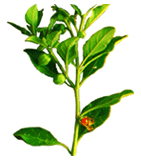
Ashwagandha
Introduction
This fact sheet provides basic information about the rasayana herb ashwagandha. It has many applications, and has been used to treat inflammation, fevers, and to protect against infection or illness. It has also been used to boost the immune system, improve memory, and to promote overall wellness.
Common Names
Ashwagandha, Indian ginseng, Winter cherry, Ajagandha, Kanaje Hindi, Samm Al Ferakh
Latin Names
Withania somnifera
What It Is Used For
- Ashwagandha is often used in formulations prescribed for stress, strain, fatigue, pain, skin diseases, diabetes, gastrointestinal disease, rheumatoid arthritis, and epilepsy.
- Externally, it can be applied as a local analgesic.
- It is also used as a general tonic, to increase energy and improve health and longevity.
How It Is Used
Medicinal substance derived from the root and berry of the plant.
What the Science Says
- Ashwagandha has been found to be rich in iron. Small scale human studies suggest ashwagandha may promote growth in children and improve hemoglobin level, red blood cell count, and sexual performance in adults. In addition, an herbomineral formula containing ashwagandha was shown to benefit osteoarthritis in a clinical trial.
- Ashwagandha may induce abortion, pregnant women should avoid this herb.
Side Effects and Cautions
- Slight nausea effect
- Impaired sight
Sources







